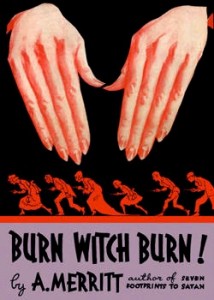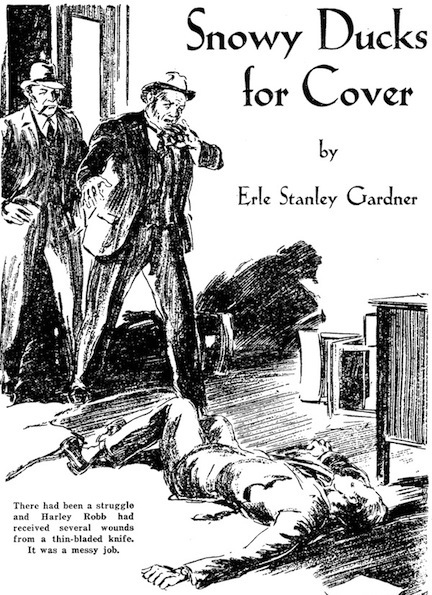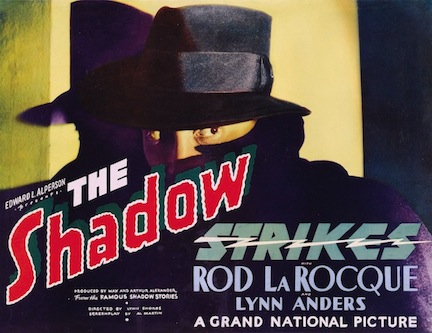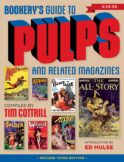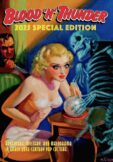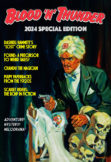EDitorial Comments
Now, THIS Is A Fan Letter….
 It’s always great to get feedback from readers of Murania Press publications, although much of it comes in the form of terse e-mails or brief notes accompanying subscription renewals (“Keep up the good work” . . . “Loved the last issue”). But every now and then I get a hum-dinger of a letter. One such came in today’s mail from Chatsworth, California’s John Carver, commenting on the first issue of Blood ‘n’ Thunder’s Western Movie Roundup:
It’s always great to get feedback from readers of Murania Press publications, although much of it comes in the form of terse e-mails or brief notes accompanying subscription renewals (“Keep up the good work” . . . “Loved the last issue”). But every now and then I get a hum-dinger of a letter. One such came in today’s mail from Chatsworth, California’s John Carver, commenting on the first issue of Blood ‘n’ Thunder’s Western Movie Roundup:
Superbly written, endlessly fascinating, beautifully produced — the preceding is not, I repeat not, hyperbole, but bedrock, unassailable fact. Congratulations.
As a result of the above-mentioned characteristics, how could anyone resist the urge to happily hurl forty bucks at you for a one-year subscription? Ancient, moss-grown, mildewed, senescent wreck that I am, if I hadn’t already packed my valises in dreaded anticipation of meeting my maker or his out-sourced first lieutenant, Lucifer, I’d be taking out a more-extensive subscription. But what slack-jawed dunce ever said that life was fair?
Here’s a nit to pick: not all of your readers (id est, me) have computers, or even want them (my television set is steam-powered). As I begged [Western Clippings editor/publisher] Boyd Magers recently, please help the dwindling but brave little band of stalwarts who are merely literate but who nevertheless want to lay their arthritic old claws on the goodies featured in your otherwise admirable magazine: be a hero to the digitally disenfranchised and please make sure that your ads and reviews also include either a telephone number and/or an actual real postal address.
Again, thanks for the dazzingly-done publication. I look forward to the next issue salivarously. Until then — Keep thy foot out of brothels, thy name off lenders’ books, thy hand out of ladies’ plackets, and defy the Foul Fiend.
Hat tip to Mr. Carver for the most entertaining feedback I’ve had in a long while. He’ll be glad to know that the second issue of Western Movie Roundup is already in the works and should be ready some time next month.
PulpFest 2013 Plans Are Underway
The PulpFest committee is delighted to announce that our 2013 convention will once again be held at the Hyatt Regency hotel in downtown Columbus, Ohio. Next year the confab will take place from Thursday, July 25th, through Sunday, July 28th. It will boast the same combination of product and programming that has made PulpFest the must-attend annual event for fans, scholars, and collectors of pulp fiction.
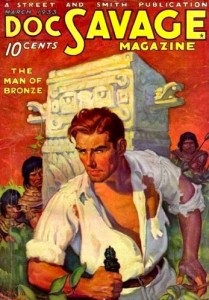 Two very important anniversary commemorations will figure prominently in PulpFest’s 2013 programming. First and foremost, we are celebrating the Hero Pulp revolution that began 80 years ago, in 1933, with the debuts of such popular figures as Doc Savage, The Spider, Nick Carter, Pete Rice, The Lone Eagle, The Phantom Detective, and G-8 and His Battle Aces. The success of Street & Smith’s Shadow pulp, launched two years earlier, spurred this revival of single-character magazines, which had been a phenomenon of the dime-novel era. The Hero Pulps revitalized an industry laid low by the Great Depression, and they dominated the rough-paper field for the rest of the decade. They remain the most avidly collected and frequently reprinted periodicals in the hobby.
Two very important anniversary commemorations will figure prominently in PulpFest’s 2013 programming. First and foremost, we are celebrating the Hero Pulp revolution that began 80 years ago, in 1933, with the debuts of such popular figures as Doc Savage, The Spider, Nick Carter, Pete Rice, The Lone Eagle, The Phantom Detective, and G-8 and His Battle Aces. The success of Street & Smith’s Shadow pulp, launched two years earlier, spurred this revival of single-character magazines, which had been a phenomenon of the dime-novel era. The Hero Pulps revitalized an industry laid low by the Great Depression, and they dominated the rough-paper field for the rest of the decade. They remain the most avidly collected and frequently reprinted periodicals in the hobby.
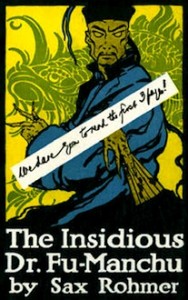 Secondarily, we acknowledge the centennial of Sax Rohmer’s Dr. Fu Manchu, who made his American bow in a February 1913 issue of Collier’s Magazine. The initial cycle of short stories was published between hard covers later that year as The Insidious Dr. Fu Manchu. The first and greatest of “Yellow Peril” villains, Rohmer’s Devil Doctor was widely imitated in all forms of American popular culture; rough-paper knockoffs included the mysterious Wu Fang and Dr. Yen Sin, both featured in short-lived pulps issued by Popular Publications in the mid Thirties. And there were many others.
Secondarily, we acknowledge the centennial of Sax Rohmer’s Dr. Fu Manchu, who made his American bow in a February 1913 issue of Collier’s Magazine. The initial cycle of short stories was published between hard covers later that year as The Insidious Dr. Fu Manchu. The first and greatest of “Yellow Peril” villains, Rohmer’s Devil Doctor was widely imitated in all forms of American popular culture; rough-paper knockoffs included the mysterious Wu Fang and Dr. Yen Sin, both featured in short-lived pulps issued by Popular Publications in the mid Thirties. And there were many others.
With so many possibilities for panels and presentations, the PulpFest committee once again plans to offer a full night of programming on Thursday, before the convention’s “official” opening on Friday, so attendees are urged to make early arrival a part of their PulpFest travel plans.
The Hyatt Regency has asked for a modest increase in guest-room rates, which will be $112 per night as opposed to the $109 we paid this year. However, to reward loyal attendees who support the convention by staying at the host hotel, PulpFest will offer a ten-dollar rebate redeemable at the Registration desk. This will cover the three-dollar nightly increase incurred by Hyatt guests.
 We are also happy to once again offer a third table free of charge to exhibitors who rent two tables in our Hucksters room. That’s three tables for the price of two, or six for the price of four. The massive size of the Regency Ballroom enables us to provide this extra exhibit space to loyal PulpFest dealers, for whose continued support we are most grateful.
We are also happy to once again offer a third table free of charge to exhibitors who rent two tables in our Hucksters room. That’s three tables for the price of two, or six for the price of four. The massive size of the Regency Ballroom enables us to provide this extra exhibit space to loyal PulpFest dealers, for whose continued support we are most grateful.
Although the 2013 convention is still ten months away, you can rest assured that the committee is already hard at work on planning and promotion. Ideas for panels and presentations have already been proposed and, as always, we remain open to programming suggestions and volunteer presenters. Most importantly, though, we wanted to let you know that our venue is confirmed. So start saving for the next PulpFest right away and check back periodically for updates.
A. Merritt’s BURN WITCH BURN, MGM’s Film Version, THE DEVIL DOLL
I enjoy comparing famous fictional works to films adapted from them. Over the weekend I revisited A. Merritt’s Burn, Witch, Burn! (1932) for the first time in more than 30 years. I finished re-reading it on Monday night, so last night I screened The Devil-Doll, its 1936 movie version, for the first time in nearly two decades. The comparison was instructive. I’m not going to give you a scene-for-scene description of either, mostly because I plan on saving that for the “Pulp Page to Silver Screen” installment in the next issue of Blood ‘n’ Thunder. But a few points are worth mentioning here, just for fun.
Merritt’s 1932 horror story — first published as a serial in Argosy, then in hard covers by Liveright — is told in the first person by a neurologist who uses the pseudonym of Dr. Lowell for reasons that “will become increasingly apparent as my recital progresses.” One night, in his New York hospital, Lowell attempts to treat a patient associated with “notorious underworld chieftain” Julian Ricori. This man, whom Ricori identifies as Thomas Peters, has collapsed for no reason and seems to exist in a twilight state, neither conscious nor unconscious, a look of unutterable terror in his eyes. His professional curiosity aroused, Lowell agrees to do what he can for the gangster despite puzzling limitations placed on him by Ricori.
Peters ultimately succumbs and the baffled neurologist finds himself drawn into a battle of wills between Ricori and one Madame Mandilip, whom the underworld boss believes to be a witch. Her eerily realistic dolls figure prominently in the story’s action and Lowell, despite his scientific grounding, comes to believe that black magic is being employed.
Burn, Witch, Burn! was the first Merritt yarn I ever read, and I’ve always thought it one of his most accessible novels. It’s held up extremely well, I think, although a few false notes still ring out. The various gangsters depicted at length seem a trifle too articulate and intelligent, not to mention loyal and cooperative. And the neurologist’s repeated insistence on disbelieving the evidence of his own eyes becomes downright annoying after he witnesses the fifth or sixth “impossible” occurrence. But Merritt skillfully conveys and sustains an atmosphere of horror, a death-from-everywhere sense of impending doom and unfathomable evil.
Tod Browning, one of the early cinema’s masters of the macabre, was no stranger to pulp fiction. Two — actually, three — of his previous hits, The Unholy Three (1925, remade in 1930) and Freaks (1932), were adapted from Tod Robbins stories originally published in All-Story Weekly and Munsey’s Magazine, respectively. Browning assiduously scoured the pages of rough-paper magazines for terrorific tales he could bring to the screen, although he’s best remembered for Dracula (1931), a loose adaptation of Bram Stoker’s novel and the play adapted from it by Hamilton Deane and John L. Balderston. It was to Garrett Fort, one of his collaborators on Dracula‘s screenplay, that Browning turned after persuading M-G-M to let him film Merritt’s novel. By rights, Burn, Witch, Burn! should have gone to Universal, Hollywood’s most prominent house of horrors, but Browning had just scored big for Metro with Mark of the Vampire (1935), which featured Dracula‘s Bela Lugosi in a part similar to his star-making role.
Three writers get screen credit for The Devil-Doll, as the Merritt adaptation was finally called: Fort, Guy Endore (author of The Werewolf of Paris and a prolific scenario scribe), and Erich von Stroheim (the legendarily eccentric actor-director, billed here as Eric). But additional dialogue and story elements were contributed by Richard Schayer (who wrote the screenplays for Universal’s first Frankenstein and Mummy movies) and Browning himself. The film — which starred Lionel Barrymore, Maureen O’Sullivan, and a host of distinguished character actors — was given top-flight production mounting and boasted some impressive special effects. Released in the summer of 1936, it was dismissed by most critics and did only fair business.
Again, I don’t want to go into detail where the story in concerned. The Devil-Doll is commercially available on DVD and plays regularly on Turner Classic Movies, so you can see it without much trouble if you’re of a mind to do so. But it’s worth noting how thoroughly — and skillfully — Browning and company transformed Burn, Witch, Burn! They retained a key plot device but completely replaced the yarn’s tone, settings, characters, and sequence of events. Perhaps most importantly, they removed every hint of the supernatural and substituted the science-fictional (none too convincingly, it should be said). I’ll save a discussion of the most intriguing plot alteration for the Blood ‘n’ Thunder article. Suffice to say that both book and film are eminently satisfying, but for wildly different reasons.
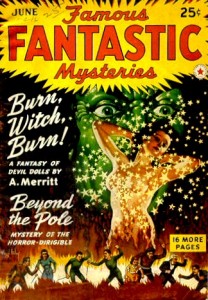 By the way, for my re-reading of Burn, Witch, Burn! I turned to the June 1942 issue of Famous Fantastic Mysteries, which reprints the entire novel in 89 pages. I have the 1932 issues of Argosy that present the story in serialized form, but I wanted to revisit Merritt’s yarn in the version featuring a great cover and interior illustrations by Virgil Finlay. This particular pulp magazine is neither difficult nor expensive to obtain, and it reprints several other great stories to boot, including Irvin S. Cobb’s classic “Fishhead.” You collectors out there who don’t have a copy might want to add this issue to your want lists.
By the way, for my re-reading of Burn, Witch, Burn! I turned to the June 1942 issue of Famous Fantastic Mysteries, which reprints the entire novel in 89 pages. I have the 1932 issues of Argosy that present the story in serialized form, but I wanted to revisit Merritt’s yarn in the version featuring a great cover and interior illustrations by Virgil Finlay. This particular pulp magazine is neither difficult nor expensive to obtain, and it reprints several other great stories to boot, including Irvin S. Cobb’s classic “Fishhead.” You collectors out there who don’t have a copy might want to add this issue to your want lists.
DIME DETECTIVE’s First Issue
In 1930 Harry Steeger and Harold S. Goldsmith launched their Popular Publications line of pulp magazines with four titles: Battle Aces, Detective Action Stories, Gang World, and Western Rangers. Popular’s initial offerings enjoyed varying degrees of success, but it wasn’t until the following year that the new company really hit pay dirt.
Newsstands across the nation displayed the first issue of Dime Detective on October 15, 1931. The William Reusswig cover portrayed a shadowy figure coming through a trap door, with a hook where his left hand should have been. Not terribly well executed, it nonetheless gave the new magazine a properly atmospheric send-off.
Dime Detective would become one of Popular’s two or three most successful pulps, with 274 issues published before its demise in mid-1953. At the beginning of its peak period (roughly 1934 to 1943) the magazine was published twice monthly.
It’s been said that Steeger intended from the first to make Dime Detective stiff competition for Black Mask, the highly regarded magazine credited with bringing the terse, hard-boiled writing style of Ernest Hemingway to pulp fiction. To this end he obtained fiction from the Mask’s most popular authors—Frederick Nebel, Carroll John Daly, and Erle Stanley Gardner—by offering them a penny a word more than they were getting from Mask editor Joseph “Cap” Shaw. But reading that first issue, as I did recently, it’s obvious that Steeger hedged his bets. Unlike Black Mask, which under Cap Shaw’s editorship totally eschewed the fanciful in crime fiction, Dime Detective in the beginning favored lead stories known to the trade as “mystery-horror.” Such yarns teased readers with seemingly supernatural elements that were explained away in the denouements. In 1931 mystery-horror was quite popular and would become even more so within a few years. By including stories of this type Steeger couldn’t be accused of going head to head with Black Mask. At least, not yet.
In a back-of-the-book department titled “How About It?”, which asked for reader feedback, the unnamed editor (reportedly Steeger himself, at that point) claimed that J. Allan Dunn agreed to write a story based on Reusswig’s cover, which had been submitted on a “spec” basis. The resulting novelette, “Shadow of the Vulture,” opened that first issue. Hardly one of Dunn’s better efforts, it describes the efforts of brilliant amateur detective Guy Livingstone to run to earth a sadistic murderer known as “The Vulture” for the giant, winged shadow he casts. The illusion of a man-sized bird of prey is furthered by the Vulture’s modus operandi: ripping open the torsos of his victims with what appear to be huge talons. Livingstone is supposed to be a brilliant Sherlockian sleuth, but his deductions are short on logic and rely upon mounds of circumstantial evidence.
The second story, Frederick Nebel’s “Death Alley,” introduces Steve Cardigan, manager of the Cosmos Detective Agency’s St. Louis branch. He’s a two-fisted private dick along the lines of Nebel’s Black Mask character Donahue, and his debut adventure hews closely to the Mask model of snappy dialogue and swift, violent action. The 10,00000-word caper begins with Cardigan determined to avenge the murder of his friend and fellow Cosmos operative Pat O’Hara, and it ends with a shootout that sends most characters to the morgue and Cardigan to the hospital. Nebel’s subsequent entries in this series are generally good and have the Black Mask stamp.
Erle Stanley Gardner’s “Snowy Ducks for Cover” introduces what was probably intended to be another Dime Detective series hero. But even though various characters constantly refer to Snowy Shane’s unorthodox methods of detection, he didn’t impress me as being particularly noteworthy. The yarn itself, involving the murder of a bank president about to be unmasked as an embezzler, struck me as routine. Gardner at this time was turning out much better stuff for both Black Mask and Detective Fiction Weekly, and this so-so story was likely placed in Dime Detective’s inaugural number just to get his name on the cover. It marked the first and last appearance of Snowy Shane, one of several mediocre series characters Gardner created for the magazine.
“The Pullman Murder,” a straightforward, fast-action, tough-as-nails novelette by T. T. Flynn, is not only the first issue’s longest story but possibly its most satisfying as well. Protagonist Bill Brady suddenly awakens from a deep sleep while in his Pullman berth. Someone has just tossed an alligator-skin Gladstone into his compartment. The bag is covered with fresh blood and contains thousands of dollars in well-used bills. Flynn’s story proceeds along classic mistaken-identity lines, with its everyman protagonist thought to be a Treasury agent in hot pursuit of counterfeiters. While cut to a familiar pattern, the yarn is fast-paced and loaded with gritty action.
Dime Detective’s first issue closes out with Edward Parrish Ware’s “The Devil’s Jackpot,” which follows Memphis-based private detective Jim Lenoir to Arkansas’s Black River country, where he’s pitted against a gang looking for a cache of priceless fresh-water pearls. Ware’s story is smoothly done and a bit tougher than his Detective Fiction Weekly tales of this period, but it’s nothing special.
Overall, I was somewhat disappointed in Volume One, Number One of Dime Detective. It’s clear Steeger had not yet decided how to slant the magazine, and the variable story quality suggests that the issue was thrown together in a hurry. Under the editorship of Ken White, Dime Detective eventually found its voice, so to speak, and became one of the top pulps of its kind.
Catching My Breath
I’m sorry I haven’t posted here more regularly of late, but it’s been busy around here. Real busy.
In recent weeks my time has been monopolized by the latest edition of Lone Pine in the Movies, an annual magazine I produce for the Lone Pine Film Festival. As some of you know, I’ve been an active participant in the Film Festival for many years — two full decades, in fact. The organizers have often called upon me to secure prints of rare movies shot in Lone Pine, and for the last six or seven years I’ve been moderating most of the celebrity panels and conducting one-on-one interviews with special guest stars. This year my chores will include interviewing actor Don Murray, whose notable films include Bus Stop (in which he played opposite Marilyn Monroe), The Bachelor Party, The Hoodlum Priest, and Advise and Consent, among many others.
Of course, honorees at the Lone Pine Film Festival are always quizzed about the movies they made in that rugged high-desert country at the base of the Sierra Nevada mountains. So I’ll also be grilling Murray about one of his earliest star vehicles, From Hell to Texas (1958), an exceptionally fine Western directed by the great Henry Hathaway.
Each issue of Lone Pine in the Movies revolves around the theme of that year’s Festival. In 2012 we celebrate the centennials of Universal and Paramount, so the articles cover motion pictures shot in the area by those two studios. As it turns out, the earliest extant Lone Pine film is a 1920 Paramount silent, The Round Up, which we’ll be screening at the Festival with live musical accompaniment. I’ve seen it before but am eager to get another look. Having spent a lot of time riding through the picturesque Alabama Hills where so many classic chase scenes were filmed, I can now recognize and revisit many of the spots seen in these old movies. In fact, that’s now a big part of my fun every year.
I’ll be leaving for California early next month but have lots to do before I go, not the least of which is finish work on The Best of Blood ‘n’ Thunder: Volume Two and the fourth book in Murania’s Classic Pulp Reprints series, H. Bedford-Jones’s 1916 historical novel, The Wilderness Trail. Also, I have several blog entries ready for posting before I leave town. Tomorrow’s: a look at the first issue of Popular Publications’ long-running pulp, Dime Detective.
Three-Day Overstock Sale!
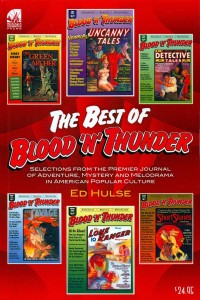 I’ve got a case of Murania Press books left over from last month’s PulpFest, and I’m going to try an experiment by discounting the three titles for which I have extra copies. So for the next three and a half days — until midnight on Monday, September 10 — I’m offering Barehanded Castaways and Blood ‘n’ Thunder’s Cliffhanger Classics, which normally sell for $24.95 including postage, at $19.95 each. The Best of Blood ‘n’ Thunder, which normally sells for $29.95 including postage, will be priced at $22.95 for the duration of the sale. Like I said, this is just an experiment in disposing of excess stock on hand, not a permanent price reduction, and the discount is only good as long as supplies last. So if by tomorrow night I’ve sold all copies of, say, Barehanded Castaways, the sale on that title is over.
I’ve got a case of Murania Press books left over from last month’s PulpFest, and I’m going to try an experiment by discounting the three titles for which I have extra copies. So for the next three and a half days — until midnight on Monday, September 10 — I’m offering Barehanded Castaways and Blood ‘n’ Thunder’s Cliffhanger Classics, which normally sell for $24.95 including postage, at $19.95 each. The Best of Blood ‘n’ Thunder, which normally sells for $29.95 including postage, will be priced at $22.95 for the duration of the sale. Like I said, this is just an experiment in disposing of excess stock on hand, not a permanent price reduction, and the discount is only good as long as supplies last. So if by tomorrow night I’ve sold all copies of, say, Barehanded Castaways, the sale on that title is over.
Update: Collectibles for Sale
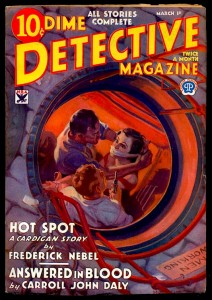 I finally managed to finish posting the new sales items I intended to upload this past weekend. There are a couple dozen fresh listings — vintage pulps, paperbacks and hardcovers. Robert E. Howard, Sax Rohmer, H. Bedford-Jones, Maxwell Grant, Arthur O. Friel, and Clarence E. Mulford are just some of the authors who are represented in these items, some of which are quite scarce and all of which — in my opinion, anyway — are very reasonably priced. Check ’em out.
I finally managed to finish posting the new sales items I intended to upload this past weekend. There are a couple dozen fresh listings — vintage pulps, paperbacks and hardcovers. Robert E. Howard, Sax Rohmer, H. Bedford-Jones, Maxwell Grant, Arthur O. Friel, and Clarence E. Mulford are just some of the authors who are represented in these items, some of which are quite scarce and all of which — in my opinion, anyway — are very reasonably priced. Check ’em out.
I intend to list more stuff over the next week or two, and still more in the weeks and months to come, so you’ll want to revisit the Collectibles page frequently lest you miss a real bargain.
The Shadow Strikes . . . 75 Years Later!
Seventy-five years ago, Grand National Films — a small Hollywood studio — released The Shadow Strikes, the initial entry in what was intended to be a series of four feature-length films adapted from the pulp-fiction adventures of Walter B. Gibson’s legendary crime fighter. The character had previously appeared in six 20-minute featurettes released by Universal Pictures during the 1931-32 season, but those “Shadow Detective” short subjects hewed to the format of radio’s Detective Story Hour, which made The Shadow a host/narrator rather than an active participant in the mystery yarns being dramatized. The Shadow Strikes was the first movie to “star” Gibson’s Master of Darkness. Based on a 1933 story titled “The Ghost of the Manor,” it cast silent-silent leading man Rod La Rocque as Lamont Cranston (whose name was misspelled “Granston” in the on-screen credits).
For various reasons The Shadow Strikes was not particularly well received. It was followed the next year by International Crime, ostensibly based on Ted Tinsley’s 1937 Shadow Magazine novel “Foxhound” but bearing even less similarity to its source than the previous film did to “Ghost of the Manor.” Grand National terminated the series following the release of the second entry, and by all accounts nobody was particularly upset by the decision.
I’ve just written an article detailing the behind-the-scenes history of these two films for the upcoming volume (Number 66) of Shadow reprints published by Anthony Tollin’s Sanctum Books. Both “Manor” and “Foxhound” appear as they did in the pages of The Shadow Magazine, uncut and accompanied by the original interior illustrations. The book is scheduled for a late October release, almost exactly 75 years to the day after The Shadow Strikes started making the rounds of America’s movie theaters.
The Return of Pulp AdventureCon
Rich Harvey’s Pulp AdventureCon, traditionally the year’s final gathering of pulp and paper collectors in the Northeast and Mid-Atlantic, will be held on Saturday, November 10, at its usual location: the Ramada Inn on Route 206 in Bordentown, New Jersey. Most if not all Pulp AdventureCon attendees drive to Rich’s show, and the Ramada Inn couldn’t be easier to find. It’s literally just a few hundred yards off Exit 7 of the New Jersey Turnpike. Hours are 10 a.m. to 5 p.m., although most dealers begin packing up an hour or so before the official closing time. Admission is $5.00 per person.
Although this show is small compared to such events as PulpFest and the Windy City confab, it regularly boasts a number of active, long-time dealers in pulps, digests, paperbacks, hardcovers, pulp reprints, and other collectibles: Adventure House, Nick Certo, Mike Chomko Books, Brendan Faulkner, Martin Grams, Paul Herman, Dave Kurzman, Walker Martin, Chuck Miller, David Saunders, and yours truly, among others. The dealer’s room isn’t large — it holds 40 to 45 tables — but the quantity and quality of material available for sale is usually pretty impressive. Over the last 11 years I’ve found and added to my collection some choice items from Pulp AdventureCon dealers. I’ve also picked up some real bargains. One year I glommed onto a high-grade copy of a scarce girly pulp, Stage and Screen Stories, which I subsequently “flipped” on eBay for 12 times what I paid for it.
Even those collectors on tight budgets can find bargains at Rich’s show but, perhaps more importantly, Pulp AdventureCon offers hobbyists a chance to assemble and socialize without the hustle and bustle of a major convention, where auctions, programming, and guest stars vie for the time of attendees. This one-day event unfolds at a relaxed pace, and its relatively small size allows for plenty of “face time” with friends and customers alike.
As more details become available I’ll relay them. Rich is retooling his website, and as soon as it’s ready I’ll post a link to it here. Stay tuned.
Recent Posts
- Windy City Film Program: Day Two
- Windy City Pulp Show: Film Program
- Now Available: When Dracula Met Frankenstein
- Collectibles Section Update
- Mark Halegua (1953-2020), R.I.P.
Archives
- March 2023
- July 2021
- May 2021
- March 2020
- February 2020
- December 2019
- November 2019
- October 2019
- September 2019
- August 2019
- May 2019
- April 2019
- March 2019
- February 2019
- December 2018
- November 2018
- October 2018
- August 2018
- June 2018
- February 2018
- December 2017
- October 2017
- September 2017
- August 2017
- May 2017
- April 2017
- February 2017
- September 2016
- August 2016
- July 2016
- June 2016
- November 2015
- October 2015
- September 2015
- August 2015
- July 2015
- June 2015
- May 2015
- April 2015
- March 2015
- February 2015
- January 2015
- August 2014
- July 2014
- June 2014
- May 2014
- April 2014
- January 2014
- December 2013
- September 2013
- August 2013
- July 2013
- June 2013
- May 2013
- April 2013
- March 2013
- February 2013
- January 2013
- December 2012
- October 2012
- September 2012
- August 2012
- July 2012
- June 2012
- May 2012
Categories
- Birthday
- Blood 'n' Thunder
- Blood 'n' Thunder Presents
- Classic Pulp Reprints
- Collectibles For Sale
- Conventions
- Dime Novels
- Film Program
- Forgotten Classics of Pulp Fiction
- Movies
- Murania Press
- Pulp People
- PulpFest
- Pulps
- Reading Room
- Recently Read
- Serials
- Special Events
- Special Sale
- The Johnston McCulley Collection
- Uncategorized
- Upcoming Books
- Western Movies
- Windy City pulp convention
Dealers
Events
Publishers
Resources
- Coming Attractions
- Field Guide to Wild American Pulp Artists
- MagazineArt.Org
- Mystery*File
- ThePulp.Net

